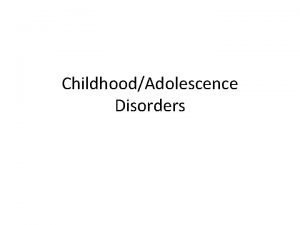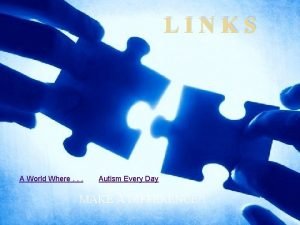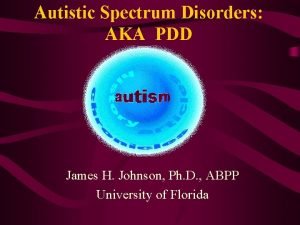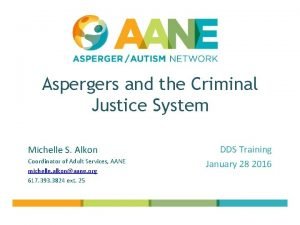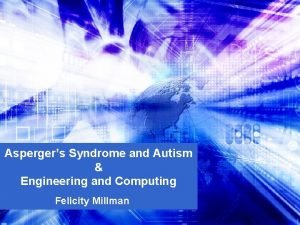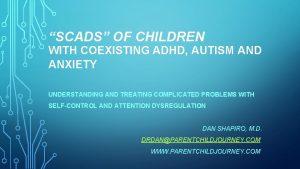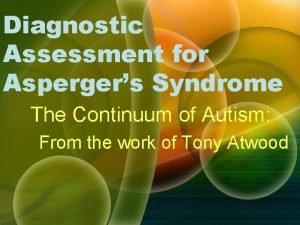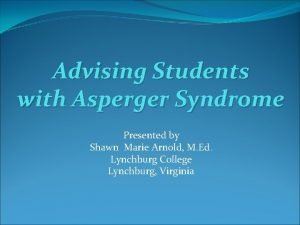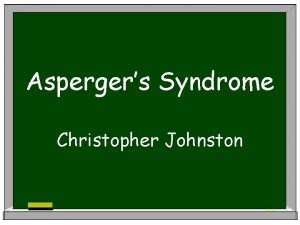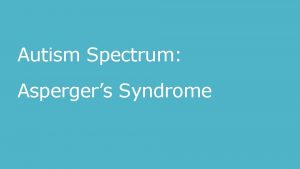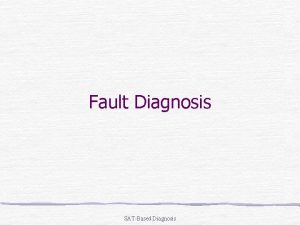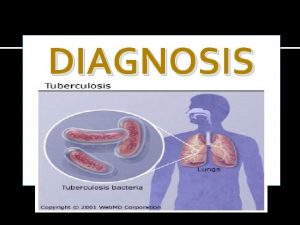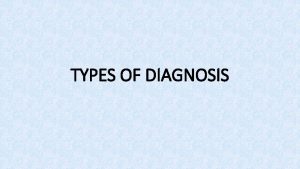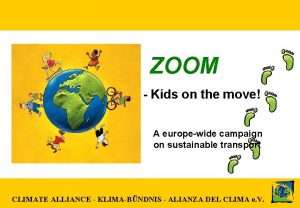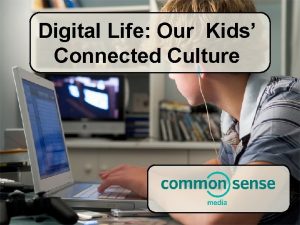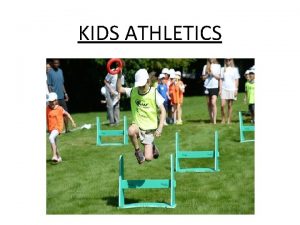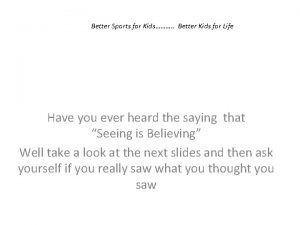WHERE DID THE KIDS WITH ASPERGERS GO Diagnosis


































- Slides: 34

WHERE DID THE KIDS WITH ASPERGER’S GO? Diagnosis and Management of Autism Spectrum Disorder in Children with Average IQ Stacey Cobb, MD Division of Child Development & Behavioral Health University of South Carolina School of Medicine

DISCLOSURE No conflicts of interest to disclose No discussion of off-label use of medications

OBJECTIVES Discuss changes in the diagnostic criteria of autism spectrum disorder. List the 3 most common co-morbidities of autism spectrum disorder in children and adolescents. Use evidence-based interventions for treatment of functionally impairing symptoms of autism spectrum disorder.

QUESTION 1 Which of the following is/are diagnostic criteria of autism spectrum disorder? A. Language delay B. Restricted and repetitive behaviors C. Aggressive behavior D. Social communication E. B and D Answer: E

QUESTION 2 Which of the following are among the most common comorbidities in autism spectrum disorder? A. Aggressive behavior B. Tics C. Sleep disorders D. ADHD and anxiety E. C and D Answer: E

QUESTION 3 Which of the following treatments has strong evidence for use in people with autism spectrum disorder? A. Amphetamine stimulants B. Oxytocin C. Cognitive behavioral therapy (CBT) D. Gluten-free diet E. Melatonin Answer: C

HISTORY OF ASPERGER SYNDROME First described in 1943 -1944 by Drs. Kanner and Asperger Subgroup of schizophrenia Manifesting from birth Improving over the course of childhood Defining features Social isolation and lack of reciprocity High linguistic skills but with atypical features Narrow focus of interests Overachievement in specific cognitive domains Motor clumsiness

AUTISM TIMELINE 1943 -44 Kanner & Asperger 1980 DSM-III Autism is not schizophrenia 1987 DSM-III R Autism criteria 1994 2013 DSM-VI DSM-5 Expands autism, adds Asperger Autism spectrum disorder

A DOOMED DIAGNOSIS Short-lived diagnostic criteria (19942013) Several differing criteria sets DSM-IV, ICD-10, research criteria PDD, NOS Autism diagnosis held precedence Asperger versus “high functioning autism” Language development Social motivation Social impact of the end of Asperger Syndrome Autism Asperger Syndrome

DSM-5: AUTISM SPECTRUM DISORDER Social Communication & Interaction Restricted, repetitive behavior or interests

DSM-5 CRITERIA Social Communication & Interaction Must meet all 3 criteria Social emotional reciprocity Nonverbal communicative behaviors Relationships

DSM-5 CRITERIA Restricted, repetitive behavior or interests Must meet 2 of 4 criteria Stereotyped or repetitive behaviors Insistence on sameness Restricted interests Sensory issues

DSM-5 CRITERIA Must be present in the early developmental periods Must cause significant impairment Not better explained by intellectual disability or global developmental delay

THE PREVALENCE PREDICAMENT ~1% of the general population 1 in 68 (1. 4%) of 8 year olds National Health Interview Survey: 1/45 4 -5 times more likely in boys Changing diagnostic criteria Increasing awareness Increasing access to therapies

BRAIN IMAGING Structural MRI Accelerated total brain volume growth, followed by arrested growth or decline Cortex follows same pattern Abnormalities of cortical gyrification Functional MRI Various regions of hypo- and hyper- reactivity associated with core features of ASD Differences in various connectivity networks Challenges Developmental changes in the brain over time

GENETICS Highly heritable, but multifactorial Environmental modulation Heterogeneity is the rule – 100’s of “autism genes” Specific etiologic factors identified 30 -40% Linkage, chromosomal, and FISH yields 6 -12% Microarray yields ~10% Whole exome and whole genome sequencing adds ~10% 10 -20% syndromic Particularly 22 q Metabolic & mitochondrial conditions Regression with fever or illness Recurrence risk of 10 -20% for siblings 30 -50% if 2 siblings are affected

ENVIRONMENTAL FACTORS Proposed risk factors Proposed protective factors Advanced maternal & paternal age Adequate maternal folate Maternal immune dysregulation Oxidative stress during pregnancy Severe maternal obesity TRAP or pesticide exposure Maternal SSRI or valproate use Perinatal complications No evidence for vaccinations as a risk factor

BEYOND THE CRITERIA

GOALS OF TREATMENT Symptom severity Overall level of symptoms Impairment/level of functioning Impact of those symptoms Treatment of ASD focuses more on improving function rather than reducing core symptoms

IMPROVING FUNCTION Educational outcomes Employment rates Self-sufficiency skills Interpersonal skills

APPLIED BEHAVIOR ANALYSIS (ABA) ABA Standard of care Intensive, individualized therapy Covered by Medicaid under federal mandate Antecedent Behavior Consequence https: //youtu. be/V 9 YDDpo 9 LWg? t=35 s

COMMON COMORBIDITIES Developmental delays Sensory issues Feeding issues Sleep disorders Psychiatric ADHD Anxiety Agitation/aggression

DEVELOPMENTAL THERAPIES Early Intervention Baby. Net and Child. Find Speech therapy Addresses specific language concerns Non verbal to difficulty with pragmatic language alone Feeding therapy Occupational therapy Sensory integration Manualized approach delivered by OT Sensory based Weighted vests/blankets, brushing, swinging

ADDITIONAL THERAPIES Cognitive Behavioral Therapy (CBT) Increasing evidence base Individual therapy superior to group therapy Social skills groups Communication, reciprocity, quality of friends Decreased loneliness and symptoms of anxiety/depression in adults with ASD Exercise Possibly beneficial Most evidence for horseback riding & martial arts

TREATMENT OF INSOMNIA Screen for underlying medical issues Reflux, allergic rhinitis, apnea, seizures Emphasize sleep hygiene No screen time for 1 hour before bed Limited evidence for pharmacologic treatment Melatonin with best evidence

COMMON PSYCHOPHARMCOLOGY Stimulants ADHD symptoms Methylphenidate preferred over amphetamines Decreased response rate and increase side effect potential Alpha agonists ADHD symptoms Guanfacine typically longer-lasting and less sedating Selective serotonin reuptake inhibitors Anxiety/depression Atypical antipsychotics Agitation and aggression Risperidone – weight gain more likely Aripiprazole – movement disorders more likely None treat core symptoms of ASD!

COMPLEMENTARY & ALTERNATIVE TREATMENT APPROACHES Neurofeedback Increasing evidence, likely to possibly efficacious Out-of-pocket costs often high Alternative treatments Vitamin supplementation Exclusion diets Chiropractic adjustments Hyperbaric oxygen Chelation therapy

EMERGING RESEARCH Oxytocin Decrease in core ASD symptoms with single dose treatment Improved social interaction Increased activity on f. MRI Continuous treatment RCT’s have failed to show clinical effects Difficulty measuring outcomes Non-optimized dose and duration

AUTISM IN THE CLASSROOM ~60% of students with ASD in regular classrooms Poorer outcomes than non-ASD students Increased risk of being bullied Negative behavior reports Lower academic achievement High incidence of anxiety Lack of protective factors Benefit from exposure to typical peers Various behavior supports in the classroom Sensory breaks Visual schedules Social skills groups

TRANSITIONS Academic College or tech school Certificate programs Carolina LIFE, Clemson LIFE, College of Charleston REACH, Coastal Carolina LIFE Employment Vocational training Adaptive skills Personal care Community-based skills Self advocacy Thinkcollege. net

ASD & VIOLENCE No evidence of link between ASD & violence Risk factors for violence in ASD Psychiatric disorder Poor social cognition Theory of mind, empathy Poor emotional regulation Reducing risk Early treatment of psychiatric disorders Social skills training, CBT Treatment of agitation

RESOURCES Autism Speaks Toolkits (free downloads) First Concern to Action Dentist, blood draws, constipation, pica Many more! Learn the Signs. Act Early. (CDC)

WORLD AUTISM AWARENESS DAY APRIL 2

REFERENCES American Psychiatric Association. (2013). Diagnostic and statistical manual of mental disorders. 5 th ed. Arlington, VA: APA. Bremer, E. , Crozier, M. , & Lloyd, M. (2016). A systematic review of the behavioural outcomes following exercise interventions for children and youth with autism spectrum disorder. Autism: The International Journal of Research and Practice. Buck, T. R. , Viskochil, J. , Farley, M. , Coon, H. , Mc. Mahon, W. M. , Morgan, J. , & Bilder, D. A. (2014). Psychiatric comorbidity and medication use in adults with autism spectrum disorder. Journal of Autism and Developmental Disorders, 44(12), 3063– 3071. Case-Smith, J. , Weaver, L. L. , & Fristad, M. A. (2015). A systematic review of sensory processing interventions for children with autism spectrum disorders. Autism: The International Journal of Research and Practice, 19(2), 133– 148. Gadow, K. D. , Guttmann-Steinmetz, S. , Rieffe, C. , & Devincent, C. J. (2012). Depression symptoms in boys with autism spectrum disorder and comparison samples. Journal of Autism and Developmental Disorders, 42(7), 1353– 1363. Ha, S. , Sohn, I. -J. , Kim, N. , Sim, H. J. , & Cheon, K. -A. (2015 a). Characteristics of Brains in Autism Spectrum Disorder: Structure, Function and Connectivity across the Lifespan. Experimental Neurobiology, 24(4), 273– 284. Im, D. S. (2016). Template to Perpetrate: An Update on Violence in Autism Spectrum Disorder. Harvard Review of Psychiatry, 24(1), 14– 35. Lee, S. Y. , Lee, A. R. , Hwangbo, R. , Han, J. , Hong, M. , & Bahn, G. H. (2015). Is Oxytocin Application for Autism Spectrum Disorder Evidence-Based? Experimental Neurobiology, 24(4), 312– 324. Malow, B. A. , Byars, K. , Johnson, K. , Weiss, S. , Bernal, P. , Goldman, S. E. , Sleep Committee of the Autism Treatment Network. (2012). A practice pathway for the identification, evaluation, and management of insomnia in children and adolescents with autism spectrum disorders. Pediatrics, 130 Suppl 2, S 106– 124. Marrus, N. , Underwood-Riordan, H. , Randall, F. , Zhang, Y. , & Constantino, J. N. (2014). Lack of effect of risperidone on core autistic symptoms: data from a longitudinal study. Journal of Child and Adolescent Psychopharmacology, 24(9), 513– 518. Matelski, L. , & Van de Water, J. (2016). Risk factors in autism: Thinking outside the brain. Journal of Autoimmunity, 67, 1– 7. Peñagarikano, O. (2015). New Therapeutic Options for Autism Spectrum Disorder: Experimental Evidences. Experimental Neurobiology, 24(4), 301– 311. Schaefer, G. B. (2016). Clinical Genetic Aspects of ASD Spectrum Disorders. International Journal of Molecular Sciences, 17(2). Spain, D. , & Blainey, S. H. (2015). Group social skills interventions for adults with high-functioning autism spectrum disorders: A systematic review. Autism: The International Journal of Research and Practice, 19(7), 874– 886. Yamasue, H. (2016). Promising evidence and remaining issues regarding the clinical application of oxytocin in autism spectrum disorders. Psychiatry and Clinical Neurosciences, 70(2), 89– 99. Zablotsky, B. , Black, L. I. , Maenner, M. J. , Schieve, L. A. , & Blumberg, S. J. (2015). Estimated Prevalence of Autism and Other Developmental Disabilities Following Questionnaire Changes in the 2014 National Health Interview Survey. National Health Statistics Reports, (87), 1– 20.
 Kids r kids west cobb
Kids r kids west cobb Aspergers
Aspergers Nursing diagnosis for mental retardation
Nursing diagnosis for mental retardation Social skills training for aspergers
Social skills training for aspergers Whats aspergers syndrom
Whats aspergers syndrom Aspbergers vs autism
Aspbergers vs autism Aspergers and criminal behavior
Aspergers and criminal behavior Aspergers example
Aspergers example Is aspergers genetic
Is aspergers genetic Aspergers vs autism
Aspergers vs autism Aspergers assessment
Aspergers assessment Strengths of aspergers
Strengths of aspergers Perbedaan diagnosis gizi dan diagnosis medis
Perbedaan diagnosis gizi dan diagnosis medis Actual diagnosis
Actual diagnosis Medical diagnosis and nursing diagnosis difference
Medical diagnosis and nursing diagnosis difference Nursing process and critical thinking
Nursing process and critical thinking Types of nursing diagnosis
Types of nursing diagnosis Bổ thể
Bổ thể Từ ngữ thể hiện lòng nhân hậu
Từ ngữ thể hiện lòng nhân hậu Tư thế ngồi viết
Tư thế ngồi viết Thế nào là giọng cùng tên?
Thế nào là giọng cùng tên? Thơ thất ngôn tứ tuyệt đường luật
Thơ thất ngôn tứ tuyệt đường luật Hát lên người ơi
Hát lên người ơi Sự nuôi và dạy con của hươu
Sự nuôi và dạy con của hươu Diễn thế sinh thái là
Diễn thế sinh thái là đại từ thay thế
đại từ thay thế Vẽ hình chiếu vuông góc của vật thể sau
Vẽ hình chiếu vuông góc của vật thể sau Công thức tiính động năng
Công thức tiính động năng Phép trừ bù
Phép trừ bù Tỉ lệ cơ thể trẻ em
Tỉ lệ cơ thể trẻ em Thế nào là mạng điện lắp đặt kiểu nổi
Thế nào là mạng điện lắp đặt kiểu nổi Lời thề hippocrates
Lời thề hippocrates Vẽ hình chiếu đứng bằng cạnh của vật thể
Vẽ hình chiếu đứng bằng cạnh của vật thể Quá trình desamine hóa có thể tạo ra
Quá trình desamine hóa có thể tạo ra Môn thể thao bắt đầu bằng từ đua
Môn thể thao bắt đầu bằng từ đua


